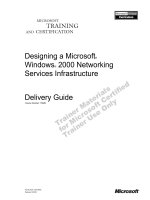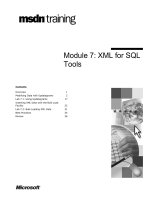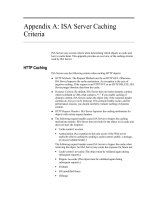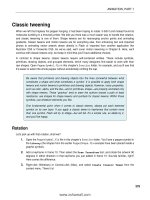Tài liệu Appendix A: Planning for Microsoft .NET ppt
Bạn đang xem bản rút gọn của tài liệu. Xem và tải ngay bản đầy đủ của tài liệu tại đây (648.86 KB, 12 trang )
Contents
Overview 1
Visual Studio.NET 2
Resources on .NET 8
Appendix A: Planning
for Microsoft .NET
Information in this document is subject to change without notice. The names of companies,
products, people, characters, and/or data mentioned herein are fictitious and are in no way intended
to represent any real individual, company, product, or event, unless otherwise noted. Complying
with all applicable copyright laws is the responsibility of the user. No part of this document may
be reproduced or transmitted in any form or by any means, electronic or mechanical, for any
purpose, without the express written permission of Microsoft Corporation. If, however, your only
means of access is electronic, permission to print one copy is hereby granted.
Microsoft may have patents, patent applications, trademarks, copyrights, or other intellectual
property rights covering subject matter in this document. Except as expressly provided in any
written license agreement from Microsoft, the furnishing of this document does not give you any
license to these patents, trademarks, copyrights, or other intellectual property.
2001 Microsoft Corporation. All rights reserved.
Microsoft, Active Directory, ActiveX, BizTalk Server, FoxPro, FrontPage, Hotmail, Jscript,
Outlook, PowerPoint, Visio, Visual Basic, Visual C#, Visual C++, Visual Studio, Windows, and
Windows NT are either registered trademarks or trademarks of Microsoft Corporation in the
U.S.A. and/or other countries.
Other product and company names mentioned herein may be the trademarks of their respective
owners.
Appendix A: Planning for Microsoft .NET 1
Overview
Visual Studio.NET
Resources on .NET
*****************************I
LLEGAL FOR
N
ON
-T
RAINER
U
SE
*****************************
Many of the servers and tools that are part of the Microsoft
®
.NET Framework
were still in development at the time this course was developed. This appendix
serves as a reference section that can be used after attending the course to help
you locate the latest news and information about the products that are part of
the .NET Framework.
If time permits, you can
teach this appendix, similar
to a module, by using the
Microsoft PowerPoint
®
file
2260A_XA.ppt.
2 Appendix A: Planning for Microsoft .NET
Visual Studio.NET
Visual Basic.NET
Visual C++.NET
Visual C#
*****************************I
LLEGAL FOR
N
ON
-T
RAINER
U
SE
*****************************
The Microsoft Visual Studio.NET suite of products represents a significant step
forward in the domain of Web-development tools. The tools integrate with the
.NET Framework components and support features, such as the creation of Web
forms from within the Integrated Design Environment (IDE) and easy Web
Service development.
This section focuses on the following languages that are part of Visual
Studio.NET:
Microsoft Visual Basic.NET
Microsoft Visual C++.NET
Microsoft Visual C#
™
Appendix A: Planning for Microsoft .NET 3
Visual Basic.NET
Web Forms
Can be created from within Visual Basic.NET’s IDE
Consist of an HTML file that represents the Web page
and a source file that handles the page’s events
Web Services
Any procedure in your Visual Basic project can be
implemented as a Web Service
Language Improvements
Support for inheritance, polymorphism, and overloading
Additional Language Features
Free-threading models
Centralized error handling
*****************************I
LLEGAL FOR
N
ON
-T
RAINER
U
SE
*****************************
Visual Basic.NET is the next step in the evolution of Microsoft Visual Basic
®
, a
popular application development tool. Visual Basic.NET incorporates many
new language features and IDE capabilities.
Web Forms
You can use Visual Basic.NET to develop a new type of project item—the Web
form. You can design Web forms from within Visual Basic.NET's IDE. Web
forms consist of two parts:
A Hypertext Markup Language (HTML) file that represents the page when
viewed in a Web browser.
A source file that handles the page's events.
The result of this development is a Web form that runs on the Web server and
passes only the HTML form down to the Web browser. Because the code runs
on the server, Web forms are truly browser independent. Unlike Active Server
Pages (ASP), the code that runs on the server is compiled, rather than
interpreted, when needed, thereby increasing the speed of the server-side
processing.
Web Services
Visual Basic.NET allows you to quickly and easily implement any existing
function in your Visual Basic project as a Web Service. A new level of scope
(in addition to Public and Private) for your functions and sub-procedures allows
procedures to be exposed as a Web Service, rather than limiting that
functionality to the Component Object Model (COM) interface. The result is
that any Web application can call the procedure by using a Uniform Resource
Locator (URL). In addition, you will be able to add a reference to the function
from your development tools by using the URL rather than the COM interfaces.









